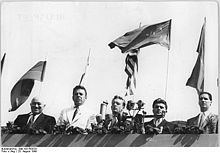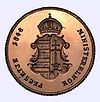- Mátyás Rákosi
-
Mátyás Rákosi 
General Secretary of the Hungarian Communist Party In office
1945 – July 18, 1956Succeeded by Ernő Gerő Chairman of the Council of Ministers of the People's Republic of Hungary In office
August 14, 1952 – July 4, 1953
(0 years, 324 days)Preceded by István Dobi Succeeded by Imre Nagy Personal details Born March 9, 1892
Ada, Austria-HungaryDied February 5, 1971 (aged 78)
Gorky, Soviet UnionNationality Hungarian Political party Hungarian Communist Party,
Hungarian Working People's PartySpouse(s) Fenia Kornilova Religion atheist The native form of this personal name is Rákosi Mátyás. This article uses the Western name order.Mátyás Rákosi (March 9, 1892[1][2] – February 5, 1971[3]) was a Hungarian communist politician. He was born as Mátyás Rosenfeld, in present-day Serbia. He was the ruler de facto of the communist Hungary between 1945 and 1956[4] — first in his capacity as General Secretary of the Hungarian Communist Party (1945–1948) and later as General Secretary of the Hungarian Working People's Party (1948–1956).[5] His rule was aligned with USSR politics during Joseph Stalin's government.[6][7]
Contents
Early years
Rákosi was born in Ada, a village in Bács County[1] in what was then the Austro-Hungarian Empire (now in Vojvodina, Serbia). Born into a Jewish family, the fourth son of a grocer (his mother would give birth to seven more children)[1] he later repudiated religion and totally repudiated Judaism, consistent with Communist doctrine, which was atheistic.[8]
He served in the Austro-Hungarian Army during the First World War and was captured on the Eastern Front. After returning to Hungary, he participated in the communist government of Béla Kun; after its fall he fled, eventually to the Soviet Union. After returning to Hungary in 1924 he was imprisoned, and was released to the Soviet Union in 1940, in exchange for the Hungarian revolutionary banners captured by the Russian troops at Világos in 1849.[9] In the Soviet Union, he became leader of the Comintern. He returned to Debrecen, Hungary, on January 30, 1945, sent by Soviet leadership, to organize the Communist Party.[9]
Leader of Hungary
When the communist government was installed in Hungary, Rákosi was appointed General Secretary of the Hungarian Communist Party (MKP). He was a member of the High National Council from September 27, to December 7, 1945. Rákosi was acting Prime Minister from February 1, to February 4, 1946 and on May 31, 1947. In 1948, the Communists forced the Social Democrats to merge with them to form the Hungarian Working People's Party (MDP). A year later, elections were held with a single list of candidates; although non-Communists nominally still figured, they were actually fellow travelers. This marked the onset of undisguised Communist rule in Hungary.
Rákosi described himself as "Stalin's best Hungarian disciple" and "Stalin's best pupil." He also invented the term "salami tactics", which related to his method of eliminating the non-Communist opposition. By portraying his rivals as either fascists or fascist sympathizers, he was able to get the non-Communist parties to push out their more courageous members, leaving only those willing to collaborate with the Communists. He later said that he destroyed the non-Communist forces in the country by "cutting them off like slices of salami." At the height of his rule, he developed a strong cult of personality around himself. Approximately 350,000 officials and intellectuals were purged under his rule, from 1948 to 1956.[10] Rákosi imposed totalitarian rule on Hungary — arresting, jailing and killing both real and imagined foes in various waves of Stalin-inspired political purges – as the country went into decline. In August 1952 he also became Chairman of the Council of Ministers, but on June 13, 1953, to appease the Soviet Politburo, he was forced to give up the office to Imre Nagy, yet retained the office of General Secretary. Rákosi led the attacks on Nagy. On 9 March 1955, the Central Committee of the Hungarian Working People's Party condemned Nagy for "rightist deviation". Hungarian newspapers joined the attacks and Nagy was accused of being responsible for the country's economic problems and on 18 April he was dismissed from his post by a unanimous vote of the National Assembly. Although Rákosi did not resume the premiership, he quickly put the country back on its previous course.
Economic policy
 Rákosi during the 2nd World Festival of Youth and Students.
Rákosi during the 2nd World Festival of Youth and Students.
The postwar Hungarian economy suffered from multiple challenges. The most important was the destruction of assets in the war (40% of national wealth, including all bridges, railways, raw materials, machinery, etc.)[11] Hungary agreed to pay war reparations approximating US$300 million, to the Soviet Union, Czechoslovakia, and Yugoslavia, and to support Soviet garrisons. The Hungarian National Bank in 1946 estimated the cost of reparations as "between 19 and 22 per cent of the annual national income." In spite of this, after the highest historical rate of inflation in world history, the new, stable currency was successfully in August 1946 on the basis of the plans of the Communist Party and the Social Democratic Party. While consumer goods production was still low, industrial production exceeded the level of 1938 by 40% in 1949 and tripled by 1953.[12] However, the backwardness of light industries resulted in frequent shortages, especially on the countryside, leading to discontent. In addition, the huge investments in military sectors after the outbreak of the Korean War further reduced the supply of consumer goods. Because of the shortages, forced savings (state bond sales to the population) and below inflation wage increases were introduced.
Forced retirement
Rákosi was then removed as General Secretary of the Party under pressure from the Soviet Politburo in June 1956 (shortly after Nikita Khrushchev's Secret Speech), and was replaced by Ernő Gerő. To remove him from the Hungarian political scene, the Soviet Politburo forced Rákosi to move to the Soviet Union in 1956, with the official story being that he was "seeking medical attention." He spent the rest of his life in the Kirgiz Soviet Socialist Republic. Shortly before his death, in 1970, Rákosi was finally granted permission to return to Hungary if he promised not to engage in any political activities. He refused the deal, and remained in the USSR where he died in Gorky in 1971.
After his death, his ashes were secretly returned to Hungary for burial in the Farkasrét Cemetery in Budapest.
Footnotes
- ^ a b c Gábor Murányi
- ^ Mátyás Rákosi - Encyclopedia.com
- ^ Matyas Rakosi - History of 1956
- ^ Matyas Rakosi - Britannica Online Encyclopedia
- ^ Bertényi Iván - Gyapai Gábor: Magyarország rövid története (Maecenas, 2001, in Hungarian)
- ^ Hungary :: The Revolution of 1956 - Britannica Online Encyclopedia
- ^ Gomori, George (November 30, 2006). "Gyorgy Litvan". The Guardian (London). http://www.guardian.co.uk/obituaries/story/0,,1960064,00.html. Retrieved May 12, 2010.
- ^ Reference for History of the Jews in Hungary - Search.com
- ^ a b Mátyás Rákosi
- ^ Granville, Johanna (2004). The First Domino: International Decision Making During the Hungarian Crisis of 1956. Texas A & M University Press, College Station, Texas. ISBN 1585442984.
Related news articles:- Johanna Granville. "The First Domino (Sample Pages) - CHAPTER 1: Roots of the Uprising - Spring 1953 to Summer 1956". tamu.edu. http://www.tamu.edu/upress/BOOKS/2003/sample/granville%20chap.pdf. Retrieved 2009-10-23.
- ^ Pető-Szakács: A hazai gazdaság négy évtizedének története 1945–1985. I. köt. Budapest, 1985, KJK
- ^ Pető-Szakács: A hazai gazdaság négy évtizedének története 1945–1985. I. köt. Budapest, 1985, KJK
Political offices Preceded by
—General Secretary of the Hungarian Communist Party
1945–1956Succeeded by
Ernő GerőPreceded by
István DobiPrime Minister of Hungary
1952–1953Succeeded by
Imre NagyPrime Ministers of Hungary since 1848 Revolution of 1848 Kingdom of Hungary Transition period M. Károlyi · Berinkey · Garbai · Peidl (opposed by G. Károlyi · Pattantyús-Ábrahám) · Friedrich · HuszárRegency Transition period Communist Hungary Republic of Hungary Italics indicates interim holderCategories:- 1892 births
- 1971 deaths
- Gulag detainees
- People from Ada (Serbia)
- Hungarian Jews
- Members of the Hungarian Working People's Party
- Members of the Hungarian Socialist Workers' Party
- Prime Ministers of Hungary
- Communist rulers
- Anti-Revisionists
- Hungarian Comintern people
- Cold War leaders
- Jewish atheists
- Hungarian atheists
- Hungarian expatriates in the Soviet Union
- Hungarian Revolution of 1956
- People's Republic of Hungary
- Stalinism
- Hungarian Communist Party politicians
Wikimedia Foundation. 2010.

